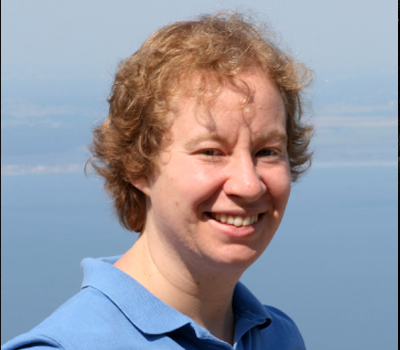Finding ways to fight infections by studying the structural composition of bacteria and super-bugs
As bacteria continue to be treated with antibiotics, we are witnessing the emergence of antibiotic-resistant pathogens capable of forming "biofilms" that further increase its immune system and antibiotic resistance. Dr. Vernita Gordon, Assistant Professor of Physics at The University of Texas at Austin, is using her background training in physics to attack biological problems from a unique perspective. Whereas most scientists studying biofilms have microbiology backgrounds, physics training prompts Dr. Gordon to ask different questions and use unique approaches. Rather than studying individual cells, Dr. Gordon and her team study "biofilms," or many interacting bacteria in a structural grouping, to understand how the structures of infections affect their function and characteristics.
Dr. Gordon's approach to infections' structure is uncovering answers that reveal how many cells of bacteria operate when functioning as a community. Current research focuses on Pseudomonas aeruginosa, a bacterium known to infect individuals with compromised immune systems. Pseudomonas is the 4th most commonly acquired infection in hospitals and is particularly dangerous, often deadly, in patients suffering from diabetes or cystic fibrosis.
- One aspect of Dr. Gordon's research studies how the structure of bacterial populations contributes to their ability to resist antibiotic treatments. Groups of many bacteria will form structures that maximize their potential to resist antibiotic treatment, and therefore thrive. Dr. Gordon and her team have discovered that manipulating the structure of bacterial populations can increase the effectiveness of antibiotics, and even enable them to eliminate antibiotic-resistant "super-bugs". The team is extending their findings to medicine by working in collaboration with the College of Pharmacy at UT Austin to develop better drug treatments.
- The structure of a biofilm is affected by the matrix of polymers that bacteria create. Bacteria can synthesize different polymers and Dr. Gordon has recently found that different polymers have different impacts on the mechanics of biofilm and that multiple polymers can combine to have synergistic effects on biofilm mechanics. A stiffer biofilm may increase bacteria survivability because the human immune system cannot perform phagocytosis, or cellular "eating", to neutralize the threat. Understanding the role mechanics plays in bacterial infections, as Dr. Gordon is working to do, will open the way for better treatment designed to alter biofilm mechanics to make the immune system better able to defend the human host.
- Bacteria are very small, typically a micron in size, and individual bacteria can only be seen under a microscope. The structures of biofilms are also at the microscopic level. Early biofilm formations are microns in size and have previously been too small to manipulate. Dr. Gordon has developed an innovative process that uses lasers to position bacteria with single-cell accuracy to manipulate the starting structure of biofilms. This enables Dr. Gordon to observe the speed at which the biofilm develops and how a biofilms shape and structure help it resist the immune system and antibiotics. These observations reveal how a biofilms structure affects the production of chemicals, and opens the opportunity for intentionally shaping biofilms to express proactive elements.
- Pseudomonas aeruginosa is the 4th most-common hospital-acquired infection. This statistic is alarming and the rate of hospital-acquired infection will grow as medical technology advances and medical treatment becomes more available. P. aeruginosa has deadly consequences for those with compromised immune systems, including people who have diabetes and cystic fibrosis. In diabetes, poor circulation prevents wounds from healing. This creates chronic wounds in which bacteria thrive. Those with cystic fibrosis and infected with Pseudomonas aeruginosa biofilms in their lungs experience a degradation of lung tissue. This prohibits the lungs from properly functioning and eventually leads to death.
Dr. Gordon's work with bacteria is revealing information fundamental to the understanding and treatment of pathogenic infections. Understanding how the structure of biofilms helps them resist treatment and damage the host, and learning how to manipulate the biofilm structure to weaken these infections, will greatly increase quality of life and the survivability for those at risk of death.
Bio
It can be argued that Dr. Vernita Gordon's career path began when she was a young child growing up in suburban Georgia, transfixed by works of science fiction and the iconic Star Trek series. An early desire to be an astronaut directed her towards an academic career in the hard sciences and engineering. During a lecture in her high school physics class, Dr. Gordon was perplexed by an issue related to rocket propulsion and the law of the conservation of momentum. It was at this point that she recognized that the field of physics was far more complex than she had initially suspected, causing her to pursue undergraduate study in physics. Graduate studies revealed an underlying interest in biological science, which explains Dr. Gordon's current multi-disciplinary work.
After earning a Bachelors of Science degree in Physics & Mathematics, Dr. Vernita Gordon studied at Harvard University, earning her Masters and Ph.D. degrees, both in Physics.
Dr. Gordon uses this physical science background to take a unique approach to biological problems.
In the News
Cystic Fibrosis News Today
Publications
Awards
Robert S. Hyer Research Award
This award is given to a team of an undergraduate researcher and his/her faculty supervisor.
Cystic Fibrosis Foundation Postdoctoral Fellow
2008-2010
Magna Cum Laude & Honors in Physics
Vanderbilt University 1997
National Merit Scholar
1993
National Honor Society
1993
Awards to Dr. Gordon's research students for work done under her supervision:
Undergraduate Nalin Ratnayeke: Robert S. Hyer Research Award, Texas Section of the American Physical Society (2013); Mitchell Award, UT Austin Co-op (2015), Dean’s Honor Graduate, UT Austin (2015)
Graduate student Karishma Kaushik: Charlie Guanntt Award for Best Oral Presentation (Graduate Student), Texas Branch of the American Society for Microbiology (2014); Best Poster Presentation – Life Sciences, University of Texas San Antonio College of Science Research Conference (2013); Bruton Continuing Fellowship, University of Texas at Austin (2014); Summer fellowship from the Microbiology graduate program (2015)
Graduate student Chris Rodesney: Downer-Focht Fellowship, Department of Physics at UT Austin (2015)


